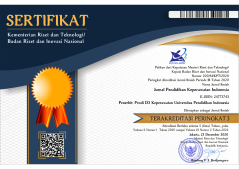Stimulasi Critical Thinking Mahasiswa Melalui Pendekatan Concept Mapping-Vignette Pada Mata Kuliah Keperawatan Anak
Abstract
ABSTRAK
Permasalahan dalam pendidikan keperawatan adalah dibutuhkannya pengembangan strategi pembelajaran yang secara aktual dapat membantu meningkatkan keterampilan critical thinking mahasiswa, khususnya dalam mata kuliah keperawatan anak. Salah satu pendekatan yang dapat diaplikasikan adalah concept mapping-vignette. Tujuan penelitian ini adalah untuk mengidentifikasi pengaruh pendekatan concept mapping-vignette dalam stimulasi critical thinking mahasiswa pada mata kuliah keperawatan anak. Penelitian ini menggunakan desain quasi-experiment post-test only with control group. Pengambilan responden menggunakan purposive sampling dengan jumlah responden sebanyak 37 orang yang terbagi menjadi kelompok intervensi sebanyak 19 orang dan kontrol sebanyak 18 orang melalui pemilihan acak. Instrumen yang digunakan dalam penelitian ini adalah California Critical Thinking Skills Test (CCTST). Hasil perhitungan statistik menunjukkan bahwa nilai p-value(0.283) lebih besar dari nilai α (0.05) yang menandakan tidak ada pengaruh signifikan pendekatan concept mapping-vignette terhadap stimulasi critical thinking mahasiswa pada mata kuliah keperawatan anak, namun responden pada kelompok intervensi memiliki nilai critical thinking relatif lebih tinggi dibandingkan dengan responden pada kelompok kontrol, khususnya pada item analisis, inferensial, evaluasi, dan deduksi. Sedangkan pada item induksi, responden pada kelompok intervensi memiliki nilai critical thinking yang lebih rendah dari kelompok kontrol. Berdasarkan pada hasil yang didapatkan, pendekatan concept mapping-vignette perlu diaplikasikan sebagai strategi pembelajaran di kelas khususnya pada mata kuliah keperawatan anak dan dapat dikembangkan untuk mata kuliah keperawatan yang lainnya. Penelitian lain perlu dilakukan dengan menggunakan instrumencritical thinking yang lain, dengan jumlah responden yang lebih besar, dan menggunakan desain pretest-posttest with control group.
ABSTRACT
The problem in nursing education is the need to develop learning strategies that can help improve students' critical thinking skills, especially in pediatric nursing course. One approach that can be applied is concept mapping-vignette. The purpose of this study was to identify the effect of the concept mapping-vignette approach in the stimulation of students' critical thinking in child nursing courses. This study was used a quasi-experiment design post-test only with a control group. The respondents were taken by purposive sampling as many as 37 people who are divided into two groups, 19 respondents as intervention group and 18 respondents as control group through random selection. The instrument used in this study was the California Critical Thinking Skills Test (CCTST). The results of statistical calculations showed that the p-value is greater than the α value (0.05), which indicates that there is no significant effect of the concept mapping-vignette approach to the stimulation of students' critical thinking in pediatric nursing course, but respondents in the intervention group have relatively higher critical thinking values compared to respondents in the control group, especially in the items of analysis, inference, evaluation, and deduction. Whereas in the induction item, respondents in the intervention group had lower critical thinking values than the control group. Based on the results, the concept mapping-vignette approach needs to be applied as a learning strategy in the classroom especially in pediatric nursing course and can be developed for other nursing courses. Another research needs to conducted using other critical thinking instruments, with a larger number of respondents and using a pretest-posttest with control group design.
Keywords
Full Text:
PDFReferences
Aein, F., Aliakbari, F. (2017). Effectiveness of Concept Mapping and Traditional Linear Nursing Care Plans on Critical Thinking Skills in Clinical Pediatric Nursing Course. Journal of Education and Health Promotion, Vol 6, No 3, Hal 1-6, DOI: 10.4103/jehp_49_14
AIPNI. (2015). Buku Kurikulum Ners. STIKes Budi Luhur Cimahi.
Aliarosa, W. (2019). Modul Keperawatan Anak. STIKes Budi Luhur Cimahi
Aliarosa, W. (2018). Nursing Students’ Skills Level of Promote Safety, Physiology Integrity, Psychosocial Integrity, and Health Promotion in Pediatric Care in a Selected Health Institute in Indonesia. Health Notions Journal, Vol 2, No 8, Hal 862-873, ISSN 2580-4936
Biro Administrasi Akademik. (2018). STIKes Budi Luhur Cimahi.
Bravo, K.S., Pozehl, B. (2016). Revision and Psychometric Testing of the Safe Administration of Medications Scale. Journal of Nursing Measurement. Vol 24, No 1, Hal 147-165, DOI: 10.1891/1061-3749.24.1.147
Broadhead, J. (2016). The Impact of Humanities-Based Teaching and Learning Strategies on Critical Thinking and Clinical Reasoning Development Among BSN Students. Dissertation: Capella University, USA
Carbogim, F.C., Barbosa, A.C., Oliviera, L.B. (2018). Educational Intervention to Improve Critical Thinking for Undergraduate Nursing Students: A Randomized Clinical Trial. Nurse Education in Practice Journal. Vol 33, Hal 121-126, DOI: 10.1016/j.nepr.2018.10.001
Gamble, A.S. (2017). Simulation in Undergraduate Paediatric Nursing Curriculum: Evaluation of a Complex ‘Ward for a Day’ Education Program. Nurse Education in Practice Journal. Vol 23, Hal 40-47, DOI: 10.1016/j.nepr.2017.02.001
Insight Assessment. (2019). Complimentary User Manual Excerpts California Critical Thinking Skills Test. The California Academic Press. San Jose, CA.
Li, Shasha, Ye, Xunchun, Chen, Wenting. (2019). Practice and Effectiveness of “Nursing Case-Based Learning” Course on Nursing Student’s Critical Thinking Ability: A Comparative Study. Nurse Education on Practice Journal, Vol 36, Hal 91-96, DOI: 10.1016/j.nepr.2019.03.007
Maldonado, S. (2014). Effects of Concept Mapping on the Critical Thinking Skills of Baccalaureate Nursing Students. Dissertation: Walden University, New York
McCormick, K. (2014). The Effect of Learning Styles, Critical Thinking Disposition, and Critical Thinking on Clinical Judgment in Senior Baccalaureate Nursing Students During Human Patient Simulation. Dissertation: The School of Nursing Southern University and A&M College, Louisiana
Miller, M.L. (2018). High Fidelity Nursing Using Electronic Health Record Systems: Impact on Critical Thinking in Nursing Practice. Dissertation: Graduate School, Valdosta State University
Piryani, R.M., Piryani, S. (2019). Clinical Vignette-Based Interactive Discussion Sessions: Feedback from Residents. Advances in Medical Education and Practice. Vol 10, Hal 829-833
Riede, P.M. (2015). Critical Thinking Skills of Beginning Associate Degree Nursing Students: A Study of Relationship Between Critical Thinking Skills And Nursing Program Success. Dissertation: Capella University, USA
Zarifsanaiey, N., Amini, M., Saadat, F. (2016). A Comparison of Educational Strategies for Acquisition of Nursing Student’s Performance and Critical Thinking: Simulation-Based Training vs. Integrated Training (Simulation and Critical Thinking Strategies). BMC Medical Education Journal. Vol 16, No 294, Hal 1-7, DOI: 10.1186/s12909-016-0812-0
DOI: https://doi.org/10.17509/jpki.v6i1.21551
Refbacks
- There are currently no refbacks.
Jurnal Pendidikan Keperawatan Indonesia(JPKI) published by Indonesia University of Education. JPKI is licensed under a Creative Commons Attribution-ShareAlike 4.0 International License.
Office :
Nursing Department. FPOK UPI.
229, Dr. Setiabudhi Street. Bandung 40154
West Java , Indonesia
E-mail : jpki@upi.edu

_.png)
_.png)
_.png)











